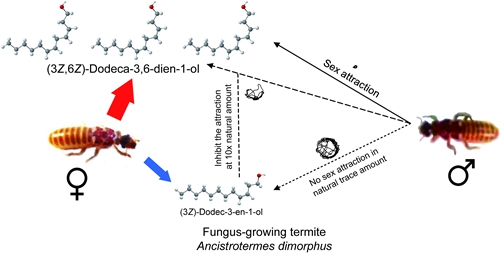Fungus-growing termites (Termitidae: Macrotermitinae) are the principal decomposers of plant organic matter in tropical areas of South Asia. The identification of termite sex pheromones is essential to design pheromone trapping of dispersing alates, an environment friendly termite control method. However, the knowledge of sex pheromones remains very fragmentary.
Researchers from Xishuangbanna Tropical Botanical Garden (XTBG) conducted a study to investigate the chemical signals used in the fungus-growing termite, A. dimorphus. They used a a combination of advanced techniques such as solid-phase microextraction (SPME), gas chromatography coupled with mass spectrometry (GC–MS), gas chromatography coupled with electroantennographic detection (GC-EAD), and behavioral bioassays.
They found that the sternal gland of a female Ancistrotermes dimorphus secreted 4 compounds. Only (3Z,6Z)-dodeca-3,6-dien-1-ol and (3Z)-dodec-3-en-1-ol were perceived by males. (3Z,6Z)-Dodeca-3,6-dien-1-ol was the female sex pheromone. (3Z,6Z)-Dodeca-3,6-dien-1-ol was the female sex pheromone.
The female sex pheromone of A. dimorphus was released from the sternal gland and the attractive effect can be explained by a single compound, (3Z,6Z)-dodeca-3,6-dien-1-ol. Moreover, they identified three additional compounds released by the sternal gland, (3Z)-dodec-3-en-1-ol, (3E,6Z)-dodeca-3,6-dien-1-ol, and (6Z)-dodec-6-en-1-ol.
(3Z)-Dodec-3-en-1-ol was electroantennographically active, and it did not provoke attraction in males, but instead had a repellent effect. Neither (3E,6Z)-dodeca-3,6-dien-1-ol nor (6Z)-dodec-6-en-1-ol elicited any antennal activity and thus the researchers considered them by-products or intermediates of the biosynthetic pathways leading to (3Z,6Z)-dodeca-3,6-dien-1-ol and (3Z)-dodec-3-en-1-ol, respectively.
Their results highlighted again the conservative nature of the chemical communication in termites.
The study entitled “Sex-pairing pheromone of Ancistrotermes dimorphus (Isoptera: Macrotermitinae)” has been published online in Journal of Insect Physiology. 
|

